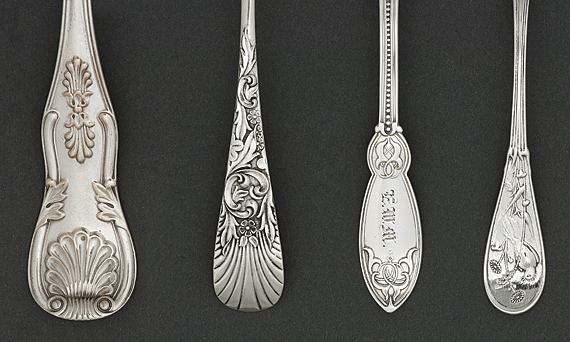 |
 |
 |
 |
|
by Lynn C. Clouser
|
The variety of decoration found on silver spoons made in America from the eighteenth to the twentieth century is staggering. Beginning with hand worked designs in the 1700s, increased mechanization, innovation and consumer demand in the 1800s led to hundreds of elaborate patterns.
|
 |
 |
 |
 |
Fig 1: Handmade spoons with downturned oval, hexagonal, and fiddle ended handles (64.68.2; 62.240.679; 61.427.2).
|
 |
Fig. 2: Tablespoon with featheredge, teaspoon and tablespoon with bright-cut decoration (89.13.6; 62.240.296; 89.13.28).
|
|
Silver spoons from the late 1700s to the early 1800s were handmade, with the bowls “sunk” by hammering into a conforming mold. The back of the bowl offered the maker a surface for decoration, giving consumers the chance to select additional stamped motifs such as a bird or shell. The amount of handle decoration often was modest, with choices for the consumer generally limited to engraved monograms or crests near the tip, and the overall handle shape. The three typical handle shapes from this period are the downturned oval handle, the hexagonal handle, and the fiddle handle (Fig. 1).
Engraving, one of the earliest processes used to decorate spoon handles, increased costs because of the additional time and labor involved. Bright-cut engraving, for example, could be quite elaborate handwork (Fig. 2). The manner in which a decorative border was achieved could provide clues as to a spoon’s time of manufacture or maker. By the early 1800s, developments for simulating hand worked borders with gravity-powered and steam-powered machines made this style of decoration more affordable.
|
 |
 |
Fig. 3: Six fiddle shaped handles with swage stamped decoration (98.4.2040; 62.240.1232; 62.240.708; 62.240.1333; 69.34; 62.240.1125).
|
The six fiddle handled spoons shown in figure 3 were made between 1820 and 1860 and show swage stamped ornaments made by multiple firms. Swage stamping was an efficient manner of handle decoration and involved an iron tool with a carved decorative motif that left a relief (reverse) image on the silver with the force of a hammer. Common variations included shells that were either convex or outlined; sheaves of wheat, which could vary from a flat image to a more three-dimensional design; and baskets of flowers, which ranged from very fine, detailed imagery to rather sloppy, poorly struck work or worn swages.
Among the several mechanical methods devised to increase spoon production in the 1800s were roller dies. Patented by New York silversmith William Gale in 1826,1 the dies had spoon patterns sunk into the rollers, allowing them to press whole designs directly into flatware blanks, saving multiple steps in production and decoration. The improved American economy and a tax on imported silverware enacted by Congress in 1842 greatly aided American silver producers2 who began to develop new mechanized processes, which streamlined production. Along with these developments, American consumers became accustomed to large silver flatware services with matching spoons, forks, knives, and other utensils, in contrast to handmade spoons from earlier eras, which, while they could be duplicated, typically were made in smaller sets.
|
 |
 |
Fig. 4: Tablespoon handle with King’s pattern and three patented teaspoon handle patterns, from left to right “Palm”, “Oriental”, and “Japanese” (61.628.5; 98.4.213; 98.4.380; 70.1220).
|
With continued innovations in production, spoon handles became more elaborate, and die-cutters were encouraged to create more intricate patterns (Fig. 4), resulting in manufacturers’ patents.3 While patenting spoon designs occurred earlier—Michael Gibney (w.c. 1836–1860) was issued the first flatware design patent in the United States on December 4, 18444—increased production and desire for diversity in choice in patterns led to greater competition among manufacturers who sought to protect their designs. Today, these patents allow researchers to identify dates of original design and names of patterns.
The collection of more than nine thousand silver spoons at Winterthur Museum and Library provides an extensive databank of the transitions in style and design from the colonial era to the late 1800s. As the collection continues to be catalogued, it will become not only an invaluable repository of maker’s marks, but an important reference for the proliferation of ornament on American silver spoon handles.
|
|
 |
Lynn C. Clouser is a researcher responsible for cataloguing the silver flatware collection at Winterthur Museum and Library. Winterthur, Delaware. All images courtesy of Winterthur Museum; photography by Jim Schneck.
|
|
 |
|
1. Charles L. Venable, Silver in America 1840–1940, A Century of Splendor (Dallas: Dallas Museum of Art., 1994), 20.
2. Venable, 19.
3. Noel D. Turner, American Silver Flatware 1837–1910 (South Brunswick: A. S. Barnes and Company, 1972), 72.
4. Dorothy T. Rainwater and Judy Redfield, Encyclopedia of American Silver Manufacturers, Revised 4th ed. (Atglen, PA: Schiffer Publishing Ltd., 1998), 121–122.
|
|
|